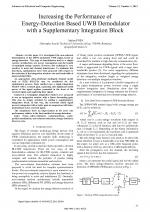| 3/2012 - 4 |
Increasing the Performance of Energy-Detection Based UWB Demodulator with a Supplementary Integration BlockPOPA, A. |
| Extra paper information in |
| Click to see author's profile in |
| Download PDF |
Author keywords
ultra-wideband communications, pulse-position modulation, non-coherent detection, energy detection, bit-error-rate
References keywords
ultra(9), systems(9), wideband(8), energy(7), communications(7), performance(6), radio(5), communication(5), pulse(4), detection(4)
Blue keywords are present in both the references section and the paper title.
About this article
Date of Publication: 2012-08-31
Volume 12, Issue 3, Year 2012, On page(s): 27 - 32
ISSN: 1582-7445, e-ISSN: 1844-7600
Digital Object Identifier: 10.4316/AECE.2012.03004
Web of Science Accession Number: 000308290500004
SCOPUS ID: 84865838612
Abstract
In this paper it is investigated the non-coherent demodulation of the 2PPM modulated UWB signal, based on energy-detection. This type of demodulation leads to a simple receiver architecture, low power consumption and the benefit of multipath energy capture. However, this technique is very sensitive to noise and channel interference. To minimize this drawback, optimizations have been proposed with respect to the reduction of the integration windows size and bandwidth of input matched filter. An appropriate ultra-wideband multipath channel model such as IEEE 802.15.3a may be considered for this optimization process. Basic method uses a single integration window with a constant gain, capturing only significant useful power of the signal replicas presented in the front of the received signal, and neglecting later signal. Instead of a rectangular integration window, it is proposed to use an integration window with a linear descending gain. This may be simply obtained by adding a supplementary integration block. In this way, the front-side useful signal power is integrated with a better gain in comparison with later, predominant noise, received signal. The simulations show an improvement in bit error rate performance relative to the basic method of energy-detection. |
| References | | | Cited By |
Web of Science® Times Cited: 3 [View]
View record in Web of Science® [View]
View Related Records® [View]
Updated 2 weeks, 6 days ago
SCOPUS® Times Cited: 3
View record in SCOPUS® [Free preview]
View citations in SCOPUS® [Free preview]
[1] Ultra-wideband Low-Noise Amplifier with Tunable Bandwidth, Yousefi, Mousa, Seyyed Najjar Hoseini, Seyyed Mojtaba, Monfaredi, Khalil, Circuits, Systems, and Signal Processing, ISSN 0278-081X, Issue 5, Volume 42, 2023.
Digital Object Identifier: 10.1007/s00034-022-02249-3 [CrossRef]
[2] An improvement for hard-decision detection of 2PPM modulated IR-UWB signals, Popa, Adrian, International Symposium on Signals, Circuits and Systems ISSCS2013, ISBN 978-1-4673-6143-9, 2013.
Digital Object Identifier: 10.1109/ISSCS.2013.6651206 [CrossRef]
[3] A 2-PPM CMOS modulator for IR-UWB signals, Popa, Adrian, Alexandru, N.D., Bozomitu, Radu Gabriel, 2016 International Conference on Communications (COMM), ISBN 978-1-4673-8197-0, 2016.
Digital Object Identifier: 10.1109/ICComm.2016.7528303 [CrossRef]
Disclaimer: All information displayed above was retrieved by using remote connections to respective databases. For the best user experience, we update all data by using background processes, and use caches in order to reduce the load on the servers we retrieve the information from. As we have no control on the availability of the database servers and sometimes the Internet connectivity may be affected, we do not guarantee the information is correct or complete. For the most accurate data, please always consult the database sites directly. Some external links require authentication or an institutional subscription.
Web of Science® is a registered trademark of Clarivate Analytics, Scopus® is a registered trademark of Elsevier B.V., other product names, company names, brand names, trademarks and logos are the property of their respective owners.
Faculty of Electrical Engineering and Computer Science
Stefan cel Mare University of Suceava, Romania
All rights reserved: Advances in Electrical and Computer Engineering is a registered trademark of the Stefan cel Mare University of Suceava. No part of this publication may be reproduced, stored in a retrieval system, photocopied, recorded or archived, without the written permission from the Editor. When authors submit their papers for publication, they agree that the copyright for their article be transferred to the Faculty of Electrical Engineering and Computer Science, Stefan cel Mare University of Suceava, Romania, if and only if the articles are accepted for publication. The copyright covers the exclusive rights to reproduce and distribute the article, including reprints and translations.
Permission for other use: The copyright owner's consent does not extend to copying for general distribution, for promotion, for creating new works, or for resale. Specific written permission must be obtained from the Editor for such copying. Direct linking to files hosted on this website is strictly prohibited.
Disclaimer: Whilst every effort is made by the publishers and editorial board to see that no inaccurate or misleading data, opinions or statements appear in this journal, they wish to make it clear that all information and opinions formulated in the articles, as well as linguistic accuracy, are the sole responsibility of the author.



